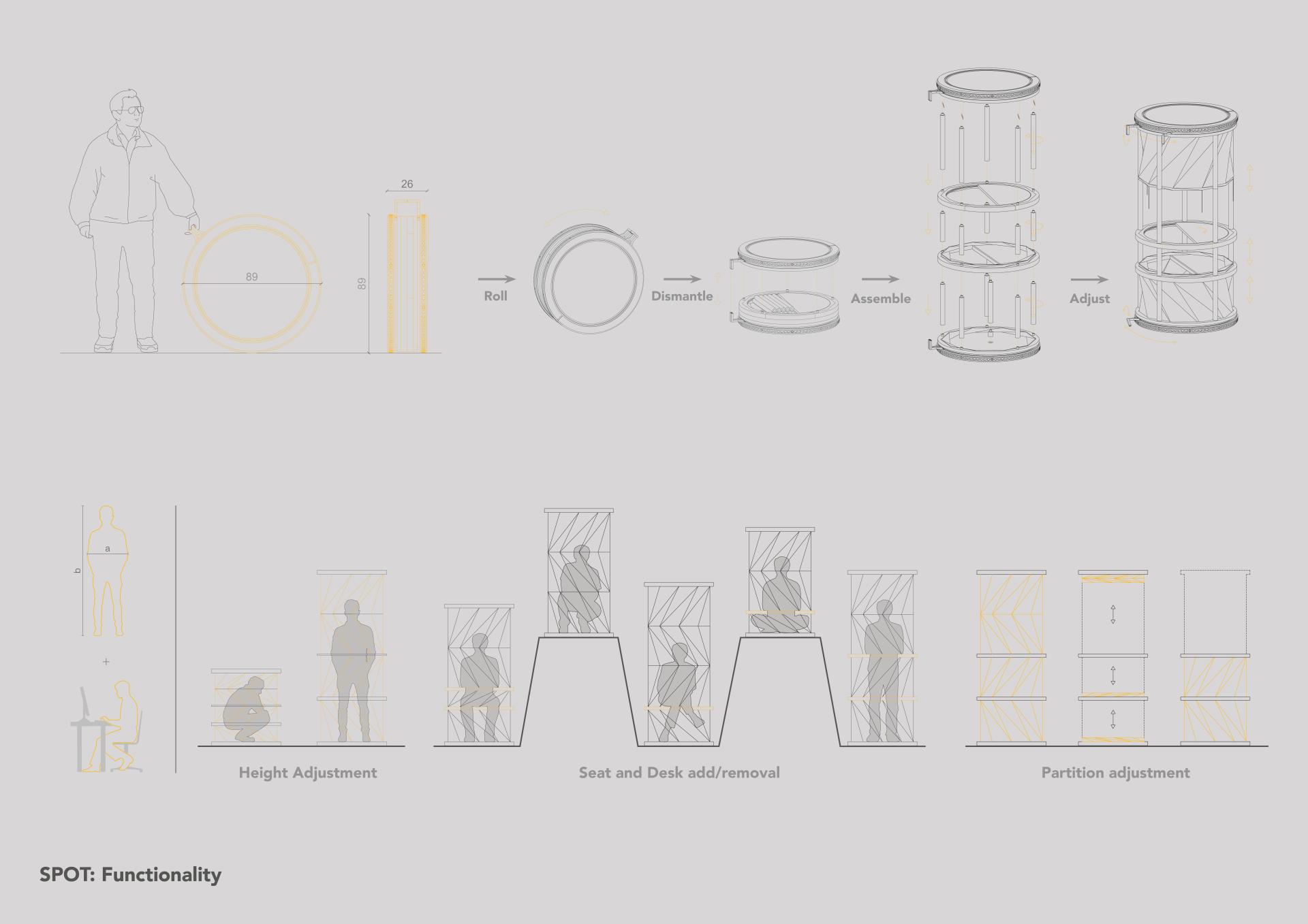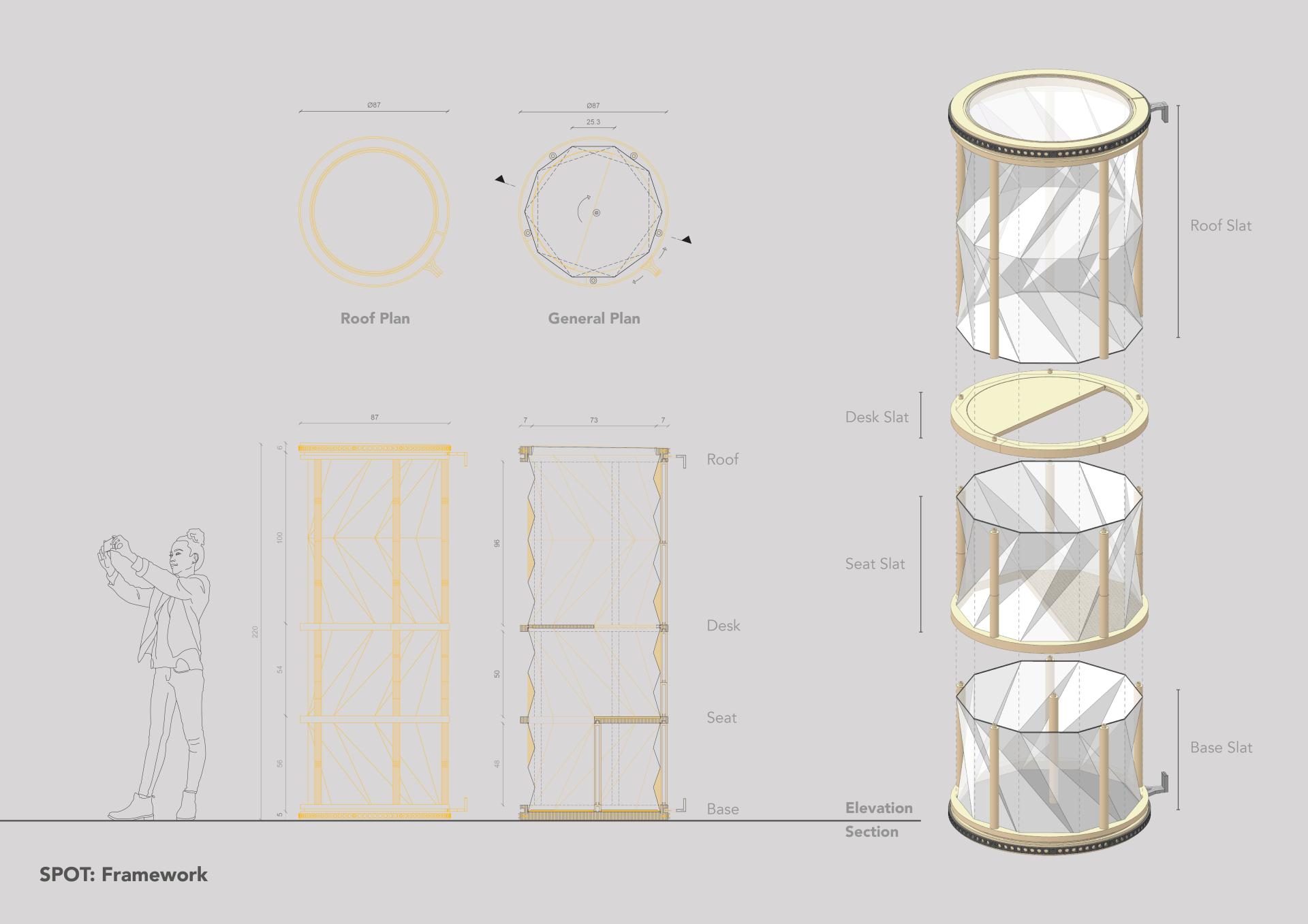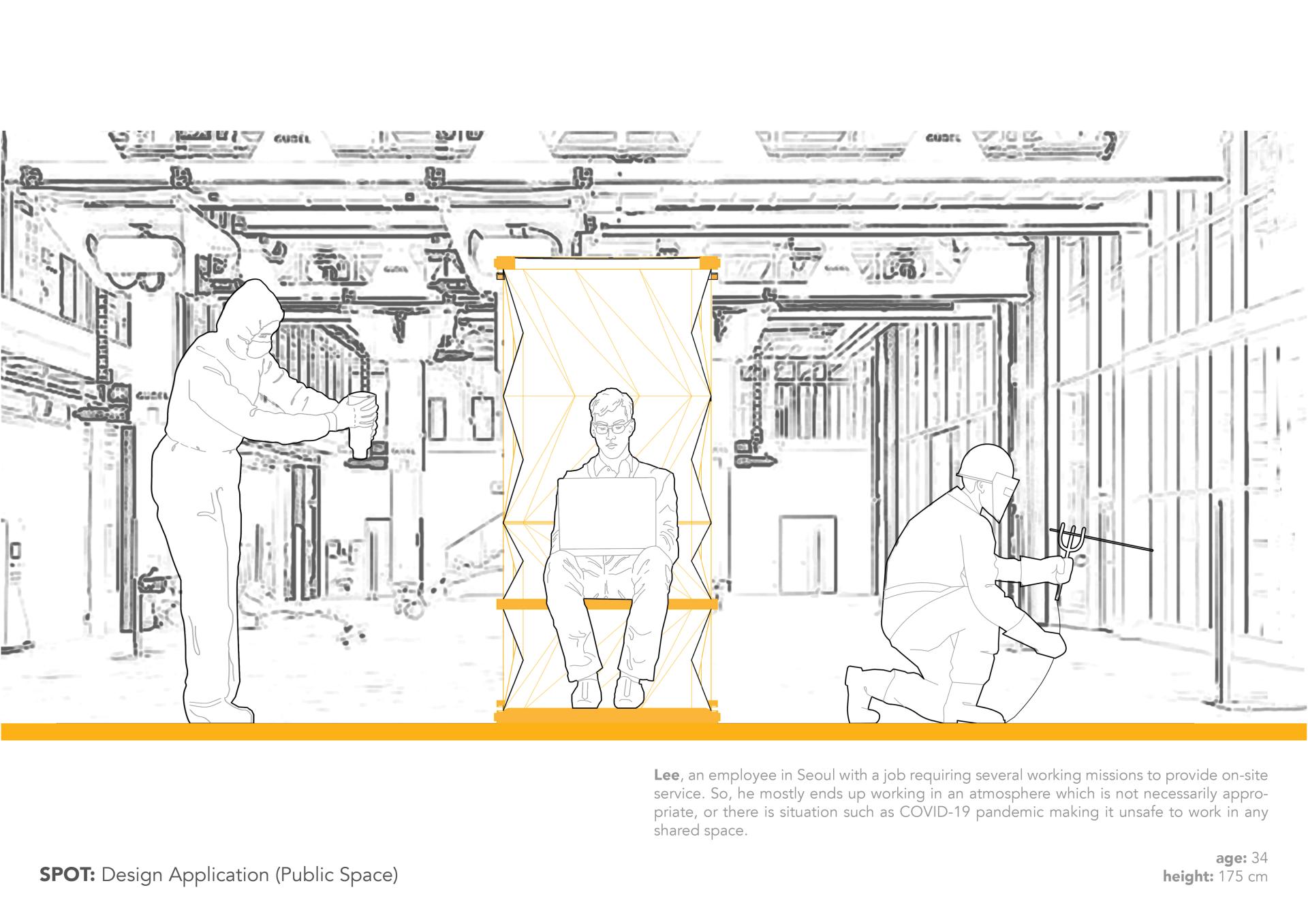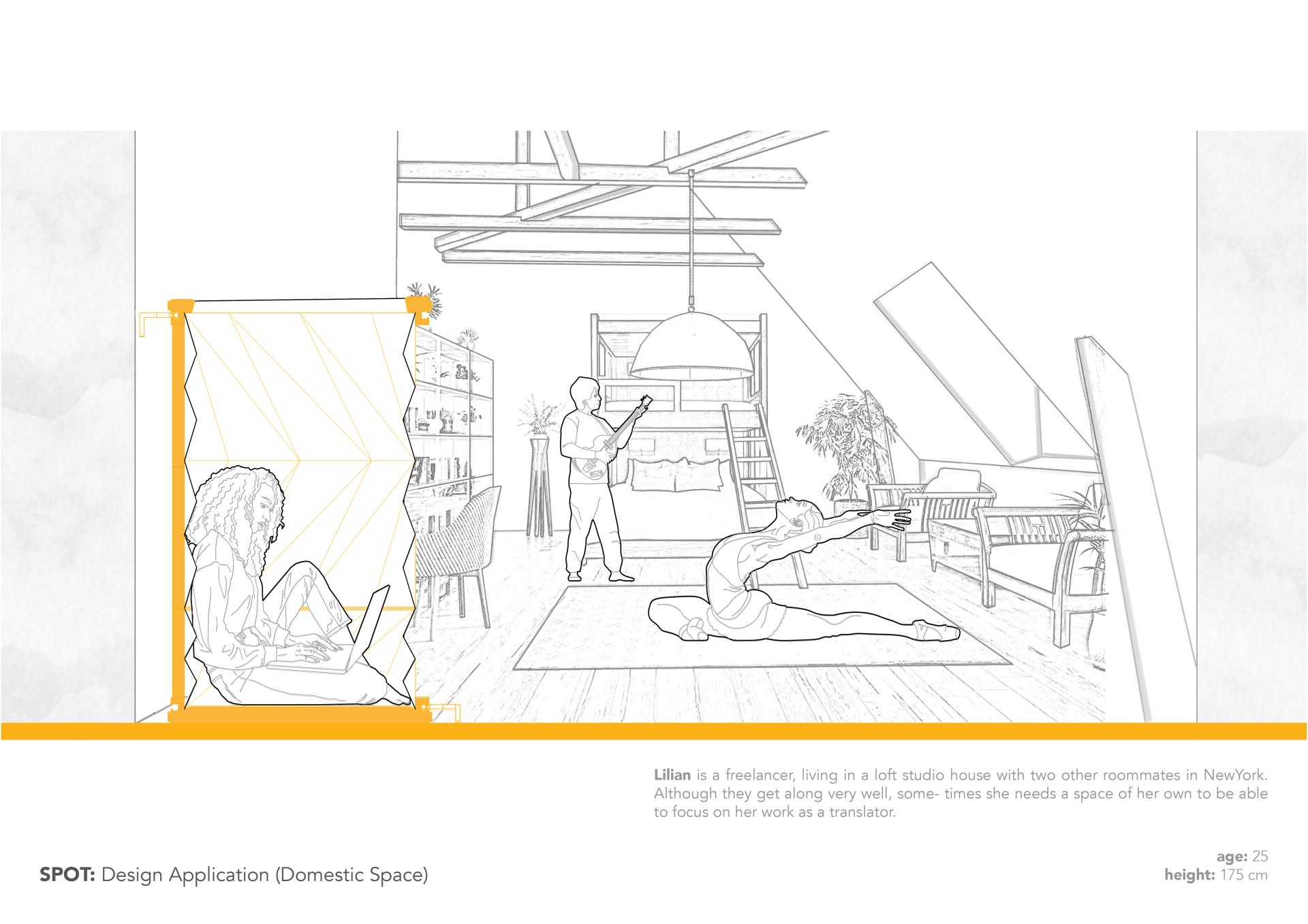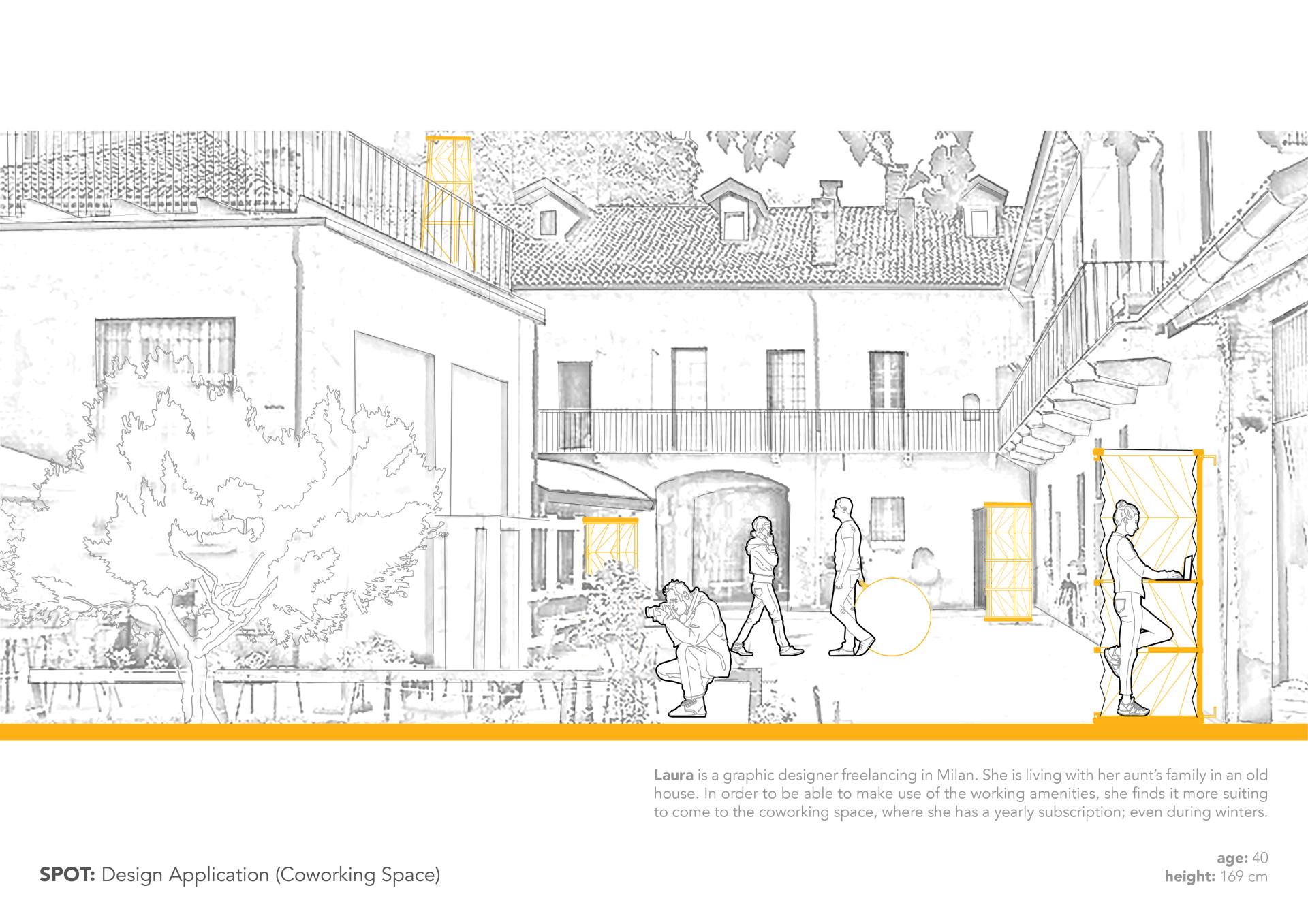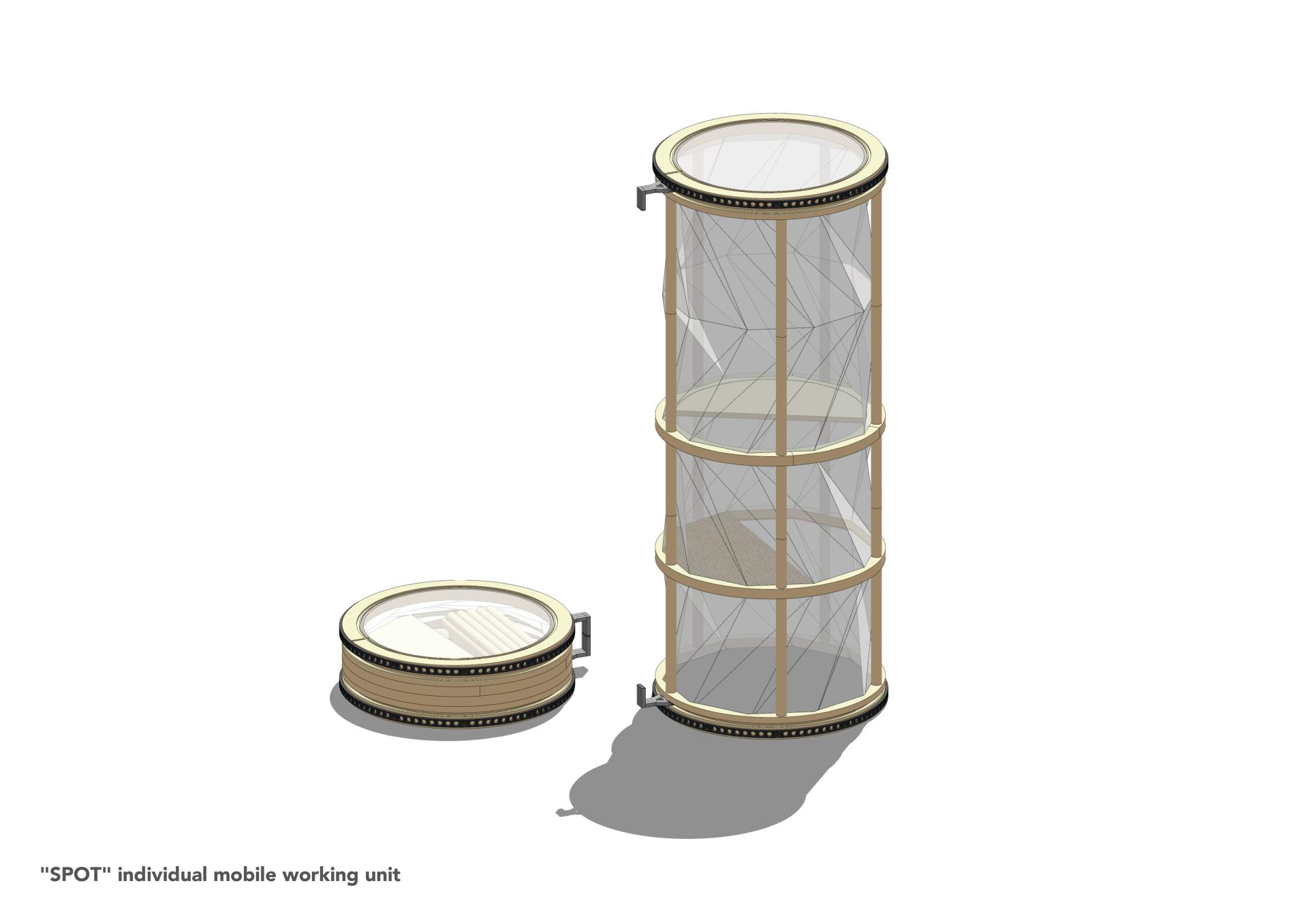SPOT
Basic information
Project Title
Full project title
Category
Project Description
Contemporary workers are becoming the modern nomads who are looking for the right spot to stay productive. This SPOT in our proposal is an individual mobile working unit, which comes with the specific material and transfer mode and is aimed at workers who need to work with flexibility of their own customized and hygienic space, in any public or private context; Promoting the idea that can work for the job missions, pandemic situations and even the future of smart working.
Geographical Scope
Project Region
Urban or rural issues
Physical or other transformations
EU Programme or fund
Which funds
Description of the project
Summary
" The best Workplace is a (spot) where your body can take the habit of Working."
SPOT - aside from its initial meaning - is an acronym, which stands for four separate words (Sustainable, Private, Optimum, Trans.ferable /formable); altogether show the main incentives of the project. These incentives are based on endeavors for responding to the important matters in the current design field; both in terms of function (as a working place) and structure (as a minimal space).
The main concept in Spot's design is to re-imagine the working place from merely an occupiable human space, to a working tool or device; A tool that can be carried around anywhere and whenever needed can be deployed and transform into a real working place with the immediate requirement for the usual "remote or nomadic working" condition; A designated human working place and the stimulus to her/his productivity with respect to proxemities.
SPOT is conceived to be a contextless unit; but as independent as it is, it always belongs to a larger setting. This setting will mostly make sense in an urban context full of working entities. Milan with its importance as a leading alpha global city and its distribution in coworking spaces can give light to the decentralized working scheme implementation of proposal in its open coworking spaces (working garden, socializing courtyard, or, etc.) These spaces are present in nearly one third of Milanese coworking spaces (33 out of 119) and are the connecting area between working and urban realm, which one can set up their workstation without following the layout of the coworking interior space but with the access to its amenities. These units then can be removed to other spaces like housings, or any public or private spaces.
And last as private as is the SPOT, it is not meant to seclude workers; The importance of the employees synergy is evident in an actual workplace, but giving it a better direction to enrich working experience is what is aimed at this project.
Key objectives for sustainability
Along with one of its main incentives, SPOT is an environment-friendly unit with the least trace on the surroundings. This is done by two initiatives;
First by the choice of functionality; Being mainly aimed at nomadic workers with working flexibility and also going along with the two scheme of 15-minute city and Near working in the city of Milan. Thus, environmentally speaking, it helps in the reduction in real-estate and carbon footprint, energy usage, greenhouse gases, traffic congestion and commuting time and also relieves pressure on transportation infrastructure. Not to mention that all of this is done by its unique structure that can be easily transported by human force and provide the optimum necessities for working.
Second by choice of Material; As a sustainable structure, it only composed of materials that are bio- degradable, recyclable or in away imposing the least harm to the environment; making the unit eco friendly as possible. These Materials include (with regard to their usage): Polyurethane-coated Honeycomb Cardboard, TPU Fabric, Polyurethane-coated Paper core, Polyurethane (PU), Synthetic Rubber from reused doormats, Aluminum (Alloy 6063), Ferrite (Magnet), Bamboo knitted fabric.
Key objectives for aesthetics and quality
Human beings are eager to use tools and objects that satisfy their vision, so SPOT takes into consideration this sense of beauty and tries to adapt itself visually:
It is a prefab foldable modular unit in the form of a cylinder or an hourglass (denoting on the temporariness) with matte translucent white shell (or any customizable color), which is striped with thin lines of stability columns (thin enough to endure mechanical forces without interfering the visibility)
It consists of four separate parts and a series of stability columns that are altogether assembled like a puzzle and mainly through static friction force, so that the connecting part stay homogenous both in expanded and closed states. Each separate part consists of a main slat, a foldable partition (three out of four parts has it), and five bases and caps for placing stability columns. Not to mention that each piece comes with the designated material with their default texture. By using a default neutral colors, it gives the possibility for being blend in and pair with almost any larger setting; be it in exterior or interior.
All in all in the design of the unit it was tried on giving a sense of lightness and delicacy as a welcoming working space, which can be further customized by the main user.
Key objectives for inclusion
Many contemporary design, working place design in particular, do not take into consideration the people's diversity or physical and psychological needs; Gender, race, age, bodily proportion, working habit and spectrum of human brain functioning (neurotypical and neurodiverse) are all part of that diversity. Despite having above average intelligence and unique abilities, not all people can always thrive within existing workplace norms and practices and are not able to work with their highest efficiency. So for a workplace to be inclusive for all, designers need to use all elements of the space in ways that appeal to people’s senses. As well as, physical working environment is an important factor underlying people's health ecosystem, influencing how they think, feel, and behave. In other words, Employees who have choice and ability to control the working environment have higher level of satisfaction, innovation and job performance
Based on these facts, SPOT is designed to be a customizable transformable unit that comes with the capability to change into different forms to accommodate different working postures and human body dimensions:
- The height of the volume (space inside), the furniture (chair and desk), and roof is adjustable.
- The roof and either of the furnitures can be added or removed.
- The partitions can be adjusted from a complete open state to a closed one.
Not to mention that the unit is built with materials that are chosen from the collection of non-expensive or reused materials, making the unit affordable as possible.
Physical or other transformations
Innovative character
SPOT is designed with selection of attempts for it as the human temporary working space to be responsive to sustainability, inclusion and aesthetics in an optimal way:
It tries to acknowledge the employees diverse needs; from the need of adjusting their own working place to incorporating specific materials that create this comfort. For an Instance, the translucent fabric partition offers both a design statement and gives opportunity for providing privacy and natural light simultaneously beside air circulation and thermal comfort. It also dampen noise throughout the space, which is also intensified by the usage of other porous materials such as fiber sheets and foams.
As a functional tool it provide them with a tool that is actually workable; the density and mechanical properties of the materials can withstand and transfer the intended dead and live loads. What's more, the materials are suitable for outside use being water and uv resistant.
As a transferable unit, all materials being of lightweight quality are totally contributing to the least weight with entailing the least volume possible; being flat-packed on transfer and deployable at the destination. Apart from having lightweight and easy roll-able transfer mode, it also complies with the required norms and dimensions; so as to be allowed to be transferred to the intended destinations by any transportation means; public or private. And, as a sustainable structure, all of its material are chosen from the selection of eco-friendly and affordable materials; with the least harm to the environment.
Therefore, it becomes an optimum and habitable space favorably enough for providing productivity and a better context for nomadic working, and in turn, offering better opportunities for people like work at home parents, caregivers and freelancers; in particular those who do not have or cannot afford a private space of their own to work in.

